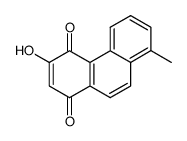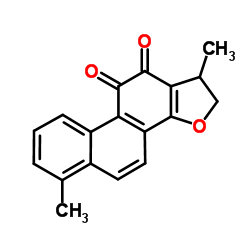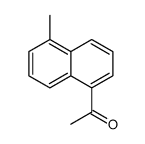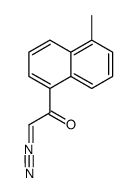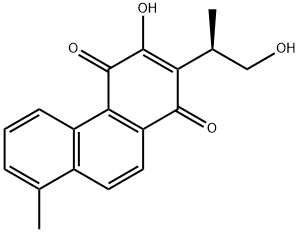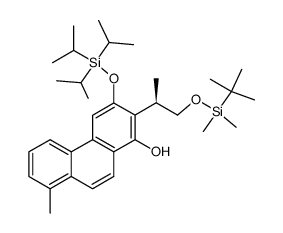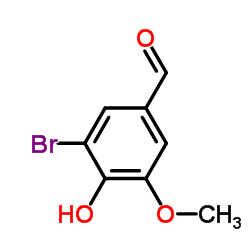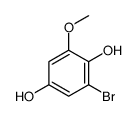568-73-0
| 中文名 | 丹参酮 I |
|---|---|
| 英文名 | Tanshinone I |
| 中文别名 |
丹参酮Ⅰ
丹参酮Ⅰ 1,6-二甲基-菲并[1,2-b]呋喃-10,11-二酮 丹参酮I 丹参醌Ⅰ 丹参醌 I |
| 英文别名 |
Salvia quinone
Phenanthro[1,2-b]furan-10,11-dione, 1,6-dimethyl- Tanshinone Tanshinon I tanshinone-I Tanshinone 1 1,6-Dimethylphenanthro[1,2-b]furan-10,11-dione TANSHINONES IIA Tanshinquinone I Tanshine I MFCD00238692 |
| 描述 | Tanshinone I 是一种IIA型人重组 sPLA2 和兔重组 cPLA2 抑制剂,IC50 分别为 11 μM 和 82 μM。 |
|---|---|
| 相关类别 | |
| 靶点 |
IC50: 11 μM (sPLA2), 82 μM (cPLA2)[1]. |
| 体外研究 | 丹参酮I抑制LPS诱导的RAW巨噬细胞形成PGE2(IC50 =38μM)。当丹参酮I与LPS同时加入时,该化合物明显抑制10-100μM的PGE2产生(IC50 =38μM)。在完全诱导COX-2后添加时,丹参酮I还会降低PGE2的产生(IC50 =46μM)。丹参酮I通过预诱导的COX-2抑制PGE 2产生的事实强烈表明该化合物可直接抑制COX-2活性和/或影响PLA2活性。当丹参酮I与两种不同形式的磷脂酶A2(PLA2)一起温育时,它以浓度依赖性方式明显抑制sPLA2(IC50 =11μM)。尽管效力较低,但丹参酮I也抑制cPLA2(IC50 =82μM)[1]。 |
| 体内研究 | 丹参酮I在大鼠角叉菜胶诱导的爪水肿和佐剂诱导的关节炎中显示出抗炎活性。为了建立丹参酮I的抗炎活性,使用经典的急性和慢性炎症动物模型[大鼠角叉菜胶(CGN)诱导的爪水肿和大鼠佐剂诱导的关节炎(AIA)]。当口服丹参酮I时,它显示出对CGN诱导的爪水肿的显着抗炎活性(在160mg/kg时抑制47%),而吲哚美辛的IC50为7.1mg/kg。在AIA中,丹参酮I在口服剂量为50mg/kg /天时在第18天给予27%的继发性炎症抑制,而泼尼松龙(5mg/kg /天)显示出有效的抑制作用(65%)[1]。 |
| 激酶实验 | 作为PLA2的来源,从用PLA2基因转染的CHO细胞中纯化人重组sPLA2(IIA型),并通过其在杆状病毒中的表达获得兔重组血小板cPLA2。标准反应混合物(200μL)含有100mM Tris-HCl缓冲液(pH9.0),含有6mM CaCl2和20nmol 1-酰基 - [1-14C] - 花生四烯酰基-sn-甘油磷酸乙醇胺(2000cpm / nmol)。或不存在丹参酮I.通过加入50ng纯化的sPLA2或cPLA2开始反应。在37℃下20分钟后,分析产生的游离脂肪酸。在这些标准条件下,在不存在丹参酮I的反应混合物中,从添加的磷脂底物中释放出约10%的游离脂肪酸[1]。 |
| 细胞实验 | 将RAW 264.7细胞与补充有10%FBS和1%抗生素的DMEM在5%CO 2下于37℃一起培养。简而言之,将细胞接种在96孔板(2×10 5个细胞/孔)中。除非另有说明,同时加入LPS(1ug / mL)和丹参酮I并孵育24小时。使用用于PGE2的EIA试剂盒测量培养基中的PGE2浓度。为了确定诱导COX-2后丹参酮I对PGE 2产生的影响,将细胞与LPS(1μg/ mL)一起温育24小时并彻底洗涤。然后,在没有LPS的情况下加入丹参酮I,并将细胞再培养24小时。从培养基中测量PGE2浓度。使用MTT测定检查丹参酮I对RAW细胞的细胞毒性。丹参酮I在100μM时没有显示出任何细胞毒性[1]。 |
| 动物实验 | 小鼠[1]为了评价丹参酮I对急性和慢性炎症动物模型的抑制活性,使用大鼠角叉菜胶(CGN)诱导的爪水肿和佐剂诱导的关节炎(AIA)模型。简而言之,将溶解在无热原的盐水(0.05mL)中的1%CGN注射到大鼠的右后爪中进行爪水肿试验。 5小时后,使用体积描记器测量处理过的爪的肿胀。在CGN注射前1小时口服给予溶解在0.5%CMC中的丹参酮I。对于AIA试验,通过将溶解在矿物油中的乳酸分枝杆菌(0.6mL /大鼠)注射到大鼠的右后爪来引起关节炎性炎症。丹参酮I每天口服给药。使用体积描记器测量经处理和未经处理的爪的膨胀。 |
| 参考文献 |
| 密度 | 1.3±0.1 g/cm3 |
|---|---|
| 沸点 | 498.0±24.0 °C at 760 mmHg |
| 熔点 | 233-234ºC |
| 分子式 | C18H12O3 |
| 分子量 | 276.286 |
| 闪点 | 245.9±15.6 °C |
| 精确质量 | 276.078644 |
| PSA | 47.28000 |
| LogP | 4.44 |
| 外观性状 | 红色 粉末 |
| 蒸汽压 | 0.0±1.3 mmHg at 25°C |
| 折射率 | 1.676 |
| 储存条件 | 2-8°C |
|
SECTION 1: Identification of the substance/mixture and of the company/undertaking Product identifiers Product name: Tanshinone I REACH No.: A registration number is not available for this substance as the substance or its uses are exempted from registration, the annual tonnage does not require a registration or the registration is envisaged for a later registration deadline.
CAS-No.: 568-73-0 Relevant identified uses of the substance or mixture and uses advised against Identified uses: Laboratory chemicals, Manufacture of substances SECTION 2: Hazards identification Classification of the substance or mixture Classification according to Regulation (EC) No 1272/2008 Chronic aquatic toxicity (Category 4), H413 For the full text of the H-Statements mentioned in this Section, see Section 16. Not a hazardous substance or mixture according to EC-directives 67/548/EEC or 1999/45/EC. Label elements Labelling according Regulation (EC) No 1272/2008 Pictogramnone Signal wordnone Hazard statement(s) H413May cause long lasting harmful effects to aquatic life. Precautionary statement(s) none Supplemental Hazardnone Statements Other hazards - none SECTION 3: Composition/information on ingredients Substances Formula: C18H12O3 Molecular Weight: 276,29 g/mol CAS-No.: 568-73-0 No components need to be disclosed according to the applicable regulations. For the full text of the H-Statements and R-Phrases mentioned in this Section, see Section 16 SECTION 4: First aid measures Description of first aid measures General advice Consult a physician. Show this safety data sheet to the doctor in attendance. If inhaled If breathed in, move person into fresh air. If not breathing, give artificial respiration. Consult a physician. In case of skin contact Wash off with soap and plenty of water. Consult a physician. In case of eye contact Flush eyes with water as a precaution. If swallowed Never give anything by mouth to an unconscious person. Rinse mouth with water. Consult a physician. Most important symptoms and effects, both acute and delayed The most important known symptoms and effects are described in the labelling (see section 2.2) and/or in section 11 Indication of any immediate medical attention and special treatment needed no data available SECTION 5: Firefighting measures Extinguishing media Suitable extinguishing media Use water spray, alcohol-resistant foam, dry chemical or carbon dioxide. Special hazards arising from the substance or mixture Carbon oxides Advice for firefighters Wear self contained breathing apparatus for fire fighting if necessary. Further information no data available SECTION 6: Accidental release measures Personal precautions, protective equipment and emergency procedures Avoid dust formation. Avoid breathing vapours, mist or gas. Ensure adequate ventilation. For personal protection see section 8. Environmental precautions Prevent further leakage or spillage if safe to do so. Do not let product enter drains. Discharge into the environment must be avoided. Methods and materials for containment and cleaning up Pick up and arrange disposal without creating dust. Sweep up and shovel. Keep in suitable, closed containers for disposal. Reference to other sections For disposal see section 13. SECTION 7: Handling and storage Precautions for safe handling Provide appropriate exhaust ventilation at places where dust is formed.Normal measures for preventive fire protection. For precautions see section 2.2. Conditions for safe storage, including any incompatibilities Store in cool place. Keep container tightly closed in a dry and well-ventilated place. Recommended storage temperature: 2 - 8 °C Store with desiccant. Specific end use(s) Apart from the uses mentioned in section 1.2 no other specific uses are stipulated SECTION 8: Exposure controls/personal protection Control parameters Components with workplace control parameters Exposure controls Appropriate engineering controls Handle in accordance with good industrial hygiene and safety practice. Wash hands before breaks and at the end of workday. Personal protective equipment Eye/face protection Use equipment for eye protection tested and approved under appropriate government standards such as NIOSH (US) or EN 166(EU). Skin protection Handle with gloves. Gloves must be inspected prior to use. Use proper glove removal technique (without touching glove's outer surface) to avoid skin contact with this product. Dispose of contaminated gloves after use in accordance with applicable laws and good laboratory practices. Wash and dry hands. The selected protective gloves have to satisfy the specifications of EU Directive 89/686/EEC and the standard EN 374 derived from it. Full contact Material: Nitrile rubber Minimum layer thickness: 0,11 mm Break through time: 480 min Material tested:Dermatril® (KCL 740 / Z677272, Size M) Splash contact Material: Nitrile rubber Minimum layer thickness: 0,11 mm Break through time: 480 min Material tested:Dermatril® (KCL 740 / Z677272, Size M) data source: KCL GmbH, D-36124 Eichenzell, phone +49 (0)6659 87300, test method: EN374 If used in solution, or mixed with other substances, and under conditions which differ from EN 374, contact the supplier of the CE approved gloves. This recommendation is advisory only and must be evaluated by an industrial hygienist and safety officer familiar with the specific situation of anticipated use by our customers. It should not be construed as offering an approval for any specific use scenario. Body Protection Choose body protection in relation to its type, to the concentration and amount of dangerous substances, and to the specific work-place., The type of protective equipment must be selected according to the concentration and amount of the dangerous substance at the specific workplace. Respiratory protection Respiratory protection is not required. Where protection from nuisance levels of dusts are desired, use type N95 (US) or type P1 (EN 143) dust masks. Use respirators and components tested and approved under appropriate government standards such as NIOSH (US) or CEN (EU). Control of environmental exposure Prevent further leakage or spillage if safe to do so. Do not let product enter drains. Discharge into the environment must be avoided. SECTION 9: Physical and chemical properties Information on basic physical and chemical properties a) AppearanceForm: solid b) Odourno data available c) Odour Thresholdno data available d) pHno data available e) Melting point/freezingMelting point/range: 229 - 234 °C point f) Initial boiling point and no data available boiling range g) Flash pointno data available h) Evapouration rateno data available i) Flammability (solid, gas) no data available j) Upper/lowerno data available flammability or explosive limits k) Vapour pressureno data available l) Vapour densityno data available m) Relative densityno data available n) Water solubilityinsoluble o) Partition coefficient: n- log Pow: 4,509 octanol/water p) Auto-ignitionno data available temperature q) Decompositionno data available temperature r) Viscosityno data available s) Explosive propertiesno data available t) Oxidizing propertiesno data available Other safety information Solubility in otherChloroform - soluble solventsAcetone - soluble SECTION 10: Stability and reactivity Reactivity no data available Chemical stability Stable under recommended storage conditions. Possibility of hazardous reactions no data available Conditions to avoid no data available Incompatible materials Strong oxidizing agents Hazardous decomposition products Other decomposition products - no data available In the event of fire: see section 5 SECTION 11: Toxicological information Information on toxicological effects Acute toxicity no data available Skin corrosion/irritation no data available Serious eye damage/eye irritation no data available Respiratory or skin sensitisation no data available Germ cell mutagenicity no data available Carcinogenicity IARC:No component of this product present at levels greater than or equal to 0.1% is identified as probable, possible or confirmed human carcinogen by IARC. Reproductive toxicity no data available Specific target organ toxicity - single exposure no data available Specific target organ toxicity - repeated exposure no data available Aspiration hazard no data available Additional Information RTECS: Not available To the best of our knowledge, the chemical, physical, and toxicological properties have not been thoroughly investigated. SECTION 12: Ecological information Toxicity no data available Persistence and degradability no data available Bioaccumulative potential no data available Mobility in soil no data available Results of PBT and vPvB assessment PBT/vPvB assessment not available as chemical safety assessment not required/not conducted Other adverse effects SECTION 13: Disposal considerations Waste treatment methods Product Offer surplus and non-recyclable solutions to a licensed disposal company. Contact a licensed professional waste disposal service to dispose of this material. Dissolve or mix the material with a combustible solvent and burn in a chemical incinerator equipped with an afterburner and scrubber. Contaminated packaging Dispose of as unused product. SECTION 14: Transport information UN number ADR/RID: -IMDG: -IATA: - UN proper shipping name ADR/RID: Not dangerous goods IMDG: Not dangerous goods IATA:Not dangerous goods Transport hazard class(es) ADR/RID: -IMDG: -IATA: - Packaging group ADR/RID: -IMDG: -IATA: - Environmental hazards ADR/RID: noIMDG Marine pollutant: noIATA: no Special precautions for user no data available SECTION 15 - REGULATORY INFORMATION N/A SECTION 16 - ADDITIONAL INFORMATION N/A |
|
~35% 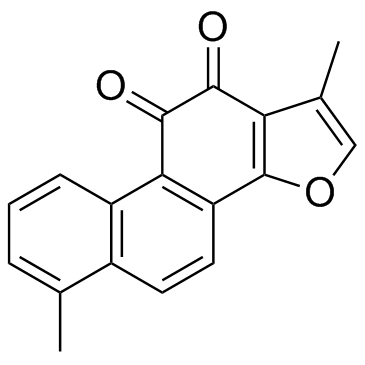
568-73-0 |
| 文献:Jiao, Mingkun; Ding, Chunyong; Zhang, Ao Tetrahedron, 2014 , vol. 70, # 18 p. 2976 - 2981 |
|
~99% 
568-73-0 |
| 文献:Danheiser, Rick L.; Casebier, David S.; Loebach, Jennifer L. Tetrahedron Letters, 1992 , vol. 33, # 9 p. 1149 - 1152 |
|
~% 
568-73-0 |
| 文献:Tetrahedron Letters, , vol. 33, # 9 p. 1149 - 1152 |
|
~% 
568-73-0 |
| 文献:Tetrahedron Letters, , vol. 33, # 9 p. 1149 - 1152 |
|
~% 
568-73-0 |
| 文献:Tetrahedron Letters, , vol. 33, # 9 p. 1149 - 1152 |
|
~% 
568-73-0 |
| 文献:Tetrahedron Letters, , vol. 33, # 9 p. 1149 - 1152 |
|
~% 
568-73-0 |
| 文献:Tetrahedron, , vol. 70, # 18 p. 2976 - 2981 |
|
~% 
568-73-0 |
| 文献:Tetrahedron, , vol. 70, # 18 p. 2976 - 2981 |
|
~% 
568-73-0 |
| 文献:Tetrahedron, , vol. 70, # 18 p. 2976 - 2981 |
| 上游产品 4 | |
|---|---|
| 下游产品 0 | |


